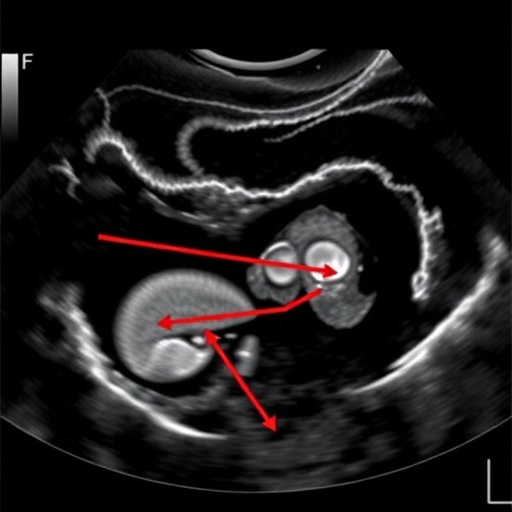In contemporary medical research, the assessment of pancreaticobiliary maljunction (PBM) in pediatric populations gains attention due to its significant role in various clinical presentations. A recent prospective study undertaken by Lai and colleagues explores innovative diagnostic methods using high-frequency ultrasonography in children. This technique showcases advancements in imaging that may improve the early detection and management of PBM, ultimately aiming to mitigate severe complications associated with this condition.
The study positions itself against a backdrop of traditional diagnosis that largely relied on invasive procedures and cross-sectional imaging. The pioneering approach outlined in this work leverages high-frequency ultrasonography, a non-invasive and readily accessible modality that holds promise for enhanced visualization of the pancreaticobiliary ductal systems. Through meticulous evaluation, the researchers elucidate how these advancements could transform the landscape of pediatric radiology, particularly in obscure cases of biliary and pancreatic disorders.
In their exploration, Lai et al. emphasize the clinical relevance of accurately diagnosing PBM at an early stage. Pancreaticobiliary maljunction is characterized by an abnormal connection between the pancreatic duct and the biliary system, leading to pancreatic juices entering the bile duct. This condition poses a risk for biliary cancers and acute pancreatitis, thereby prompting the need for timely intervention strategies. The urgency of the study is underscored by growing instances of PBM cases worldwide, particularly in young patients who are often undiagnosed.
The researchers employed a cohort of pediatric patients exhibiting symptoms indicative of biliary tract anomalies. The high-frequency ultrasonography employed harnesses advanced imaging techniques capable of revealing intricate details of the pancreaticobiliary architecture. Such precision in imaging can be vital for distinguishing PBM from other biliary pathologies, thus informing subsequent management decisions. The technology operates with greater clarity than standard ultrasound, reducing operator dependency while maximizing diagnostic accuracy.
Furthermore, the prospective nature of the study allows for a comprehensive assessment of long-term outcomes following identification of PBM. The authors meticulously analyzed the implications of their findings, indicating that early diagnosis via ultrasonography can significantly influence patient outcomes. With enhanced imaging capabilities, clinicians can make informed decisions regarding surgical intervention or ongoing monitoring protocols tailored to individual patient needs.
In a thorough examination of the imaging procedures, Lai et al. detail the technical aspects associated with high-frequency ultrasonography. The study elaborates on the optimal settings and techniques for obtaining the best possible images, emphasizing the roles of equipment selection, operator skill, and patient positioning. This detail serves not only as a how-to guide for practitioners but also reinforces the idea that meticulous execution of imaging techniques is fundamental to diagnostic success.
The study’s approach to data analysis further strengthens its credibility. A systematic evaluation of imaging results correlates with clinical outcomes, bridging the gap between diagnostic accuracy and treatment efficacy. The researchers employed both quantitative metrics and qualitative assessments to paint a comprehensive picture of how high-frequency ultrasonography impacts clinical decision-making in real-world settings.
An area worth noting is the educational implications of this research. Addressing a knowledge gap, Lai et al. call for enhanced training and integration of high-frequency ultrasonography into pediatric practice. By equipping healthcare professionals with knowledge and skills in this area, they advocate for a paradigm shift toward preventive care in pediatric patients at risk of PBM. This educational initiative is crucial for fostering a culture of proactive management in pediatric radiology.
Moreover, the findings of this study raise intriguing possibilities for future research directions. The authors suggest that further investigations could explore combining high-frequency ultrasonography with other imaging modalities. Such integrative approaches might enhance diagnostic accuracy while limiting exposure to radiation, a primary concern in pediatric healthcare. The call for inter-disciplinary collaboration also finds a place in their conclusion, as they stress the importance of radiologists, surgeons, and pediatricians working in tandem.
As the healthcare landscape continues to evolve, studies such as this by Lai et al. highlight the importance of advancing diagnostic capabilities to improve patient care outcomes. High-frequency ultrasonography stands out as a beacon of hope for children suffering from the repercussions of undiagnosed pancreaticobiliary maljunction. As clinicians adopt this novel approach, patient lives may be transformed, showcasing the tangible benefits of research-driven advancements.
In summary, the work conducted by Lai and colleagues represents a significant contribution to the field of pediatric radiology. By addressing the complexities of pancreaticobiliary maljunction through high-frequency ultrasonography, the study underscores the potential of innovative imaging techniques to reshape diagnostic and therapeutic landscapes. As healthcare continues to adapt to evolving challenges, embracing such advancements will be crucial in ensuring that pediatric patients receive the highest standard of care, further solidifying the role of imaging in contemporary medicine.
The implications of this research resonate beyond individual patients. They highlight a growing recognition of the need for early intervention strategies across medical disciplines. As more studies validate the effectiveness of high-frequency ultrasonography in various conditions, broader acceptance of this modality could follow, influencing practice at both a local and global level. Ultimately, this may lead to a new era in pediatric medicine where timely and accurate diagnoses significantly reduce the morbidity associated with previously elusive disorders.
In essence, the work by Lai et al. is a clarion call for transformation in the approach to diagnosing pancreaticobiliary disorders in children. It sets a standard for future studies aimed at harnessing technological advancements to improve patient outcomes and backs a proactive stance against conditions that pose long-term health risks.
Subject of Research: Evaluation of pancreaticobiliary maljunction in children using high-frequency ultrasonography.
Article Title: Prospective evaluation of pancreaticobiliary maljunction using high-frequency ultrasonography in children.
Article References: Lai, Y., Ling, W., Zhou, L. et al. Prospective evaluation of pancreaticobiliary maljunction using high-frequency ultrasonography in children. Pediatr Radiol (2025). https://doi.org/10.1007/s00247-025-06400-5
Image Credits: AI Generated
DOI: https://doi.org/10.1007/s00247-025-06400-5
Keywords: pancreaticobiliary maljunction, high-frequency ultrasonography, pediatric radiology, early diagnosis, imaging techniques.
Tags: biliary and pancreatic disordersclinical implications of PBM diagnosiscomplications of pancreaticobiliary maljunctionearly detection of PBMevaluation of biliary system abnormalitieshigh-frequency ultrasonography advancementsmanagement strategies for PBMnon-invasive diagnostic methodspancreaticobiliary maljunction in childrenpediatric radiology innovationspediatric ultrasound imaging techniquesrisk factors for biliary cancer in children





